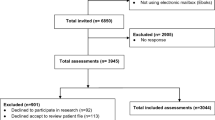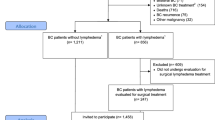Abstract
Background
Patients often fear axillary lymph node dissection (ALND) because of its associated complications; however, its effect on quality of life (QOL) is not well described. We aimed to evaluate the effect of ALND on QOL over time and to identify predictors of worse QOL.
Patients and Methods
Breast cancer patients undergoing ALND were enrolled in a prospective lymphedema screening study. Arm volumes were measured and QOL questionnaires completed at baseline, postoperatively, and at 6-month intervals. The upper limb lymphedema-27 questionnaire was used to assess the effect of upper extremity symptoms on QOL in three domains (physical, psychological, and social). Predictors of QOL were identified by univariate and multivariable regression analyses.
Results
From November 2016 through March 2020, 304 ALND patients were enrolled; 242 patients with at least two measurements and 6 months of follow-up were included. Median age was 48 years, and median follow-up was 1.2 years. The 18-month lymphedema rate was 18%. Overall, QOL scores in all three domains decreased postoperatively and improved over time. On multivariable analysis, after adjusting for baseline scores, symptoms necessitating lymphedema therapy referral (p = 0.006) were associated with worse physical QOL. Younger age (p = 0.005) and lymphedema therapy referral (p = 0.006) were associated with worse psychological QOL. Arm volume was not correlated with QOL.
Conclusions
QOL scores initially decreased after ALND but improved by 6 months post-surgery. Decreases in QOL were independent of arm volume. Patients with worse QOL more often sought lymphedema therapy, although the effect of therapy on QOL remains unknown.


Similar content being viewed by others
References
Singer S, Blettner M, Kreienberg R, et al. Breast cancer patients’ fear of treatment: results from the multicenter longitudinal study BRENDA II. Breast Care (Basel). 2015;10(2):95–100.
Lucci A, McCall LM, Beitsch PD, et al. Surgical complications associated with sentinel lymph node dissection (SLND) plus axillary lymph node dissection compared with SLND alone in the American College of Surgeons Oncology Group Trial Z0011. J Clin Oncol. 2007;25(24):3657–63.
Veronesi U, Paganelli G, Viale G, et al. A randomized comparison of sentinel-node biopsy with routine axillary dissection in breast cancer. N Engl J Med. 2003;349(6):546–53.
Baron RH, Fey JV, Borgen PI, Stempel MM, Hardick KR, Van Zee KJ. Eighteen sensations after breast cancer surgery: a 5-year comparison of sentinel lymph node biopsy and axillary lymph node dissection. Ann Surg Oncol. 2007;14(5):1653–61.
Mansel RE, Fallowfield L, Kissin M, et al. Randomized multicenter trial of sentinel node biopsy versus standard axillary treatment in operable breast cancer: the ALMANAC Trial. J Natl Cancer Inst. 2006;98(9):599–609.
Kopec JA, Colangelo LH, Land SR, et al. Relationship between arm morbidity and patient-reported outcomes following surgery in women with node-negative breast cancer: NSABP protocol B-32. J Support Oncol. 2013;11(1):22–30.
Ancukiewicz M, Russell TA, Otoole J, et al. Standardized method for quantification of developing lymphedema in patients treated for breast cancer. Int J Radiat Oncol Biol Phys. 2011;79(5):1436–43.
Launois RMA, Pocquet K, Alliot F. A specific quality of life scale in upper limb lymphedema: the ULL-27 questionnaire. In: Campisi CWM, Witte CL, editors. Progress in lymphology XVIII international congress of lymphology. Vol Lymphology 35 (Suppl):1–760, 2002: 181–187. Genoa (Italy)2001.
Wennman-Larsen A, Petersson LM, Saboonchi F, Alexanderson K, Vaez M. Consistency of breast and arm symptoms during the first two years after breast cancer surgery. Oncol Nurs Forum. 2015;42(2):145–55.
Donker M, van Tienhoven G, Straver ME, et al. Radiotherapy or surgery of the axilla after a positive sentinel node in breast cancer (EORTC 10981–22023 AMAROS): a randomised, multicentre, open-label, phase 3 non-inferiority trial. Lancet Oncol. 2014;15(12):1303–10.
McLaughlin SA, Wright MJ, Morris KT, et al. Prevalence of lymphedema in women with breast cancer 5 years after sentinel lymph node biopsy or axillary dissection: patient perceptions and precautionary behaviors. J Clin Oncol. 2008;26(32):5220–6.
Matutino ARB, Lewis J, Verma S, Taylor A, Huber S. The impact of age in the quality of life of patients diagnosed with breast cancer after curative treatment [abstract]. J Clin Oncol. 2018;36:7.
Ghanem I, Castelo B, Jimenez-Fonseca P, et al. Coping strategies and depressive symptoms in cancer patients. Clin Transl Oncol. 2020;22(3):330–6.
Acknowledgements
This study was presented in poster format at the Society of Surgical Oncology 2021 International Conference on Surgical Cancer Care Virtual Meeting, March 18–20, 2021.
Author information
Authors and Affiliations
Corresponding author
Ethics declarations
Disclosures
The preparation of this study was supported in part by NIH/NCI Cancer Center Support Grant No. P30 CA008748 to Memorial Sloan Kettering Cancer Center, and this study was supported in part by a Chanel Survivorship Endowment Award and the Manhasset Women’s Coalition Against Breast Cancer. Dr. Babak Mehrara is an advisor to PureTech Corp and the principal investigator of an investigator-initiated research grant from Regeneron Pharmaceuticals. Dr. Monica Morrow has received honoraria from Exact Sciences and Roche. All other authors have no conflicts of interest to disclose.
Additional information
Publisher's Note
Springer Nature remains neutral with regard to jurisdictional claims in published maps and institutional affiliations.
Supplementary Information
Below is the link to the electronic supplementary material.
Rights and permissions
About this article
Cite this article
Zhang, J.Q., Montagna, G., Sevilimedu, V. et al. Longitudinal Prospective Evaluation of Quality of Life After Axillary Lymph Node Dissection. Ann Surg Oncol 29, 4127–4136 (2022). https://doi.org/10.1245/s10434-022-11623-z
Received:
Accepted:
Published:
Issue Date:
DOI: https://doi.org/10.1245/s10434-022-11623-z




